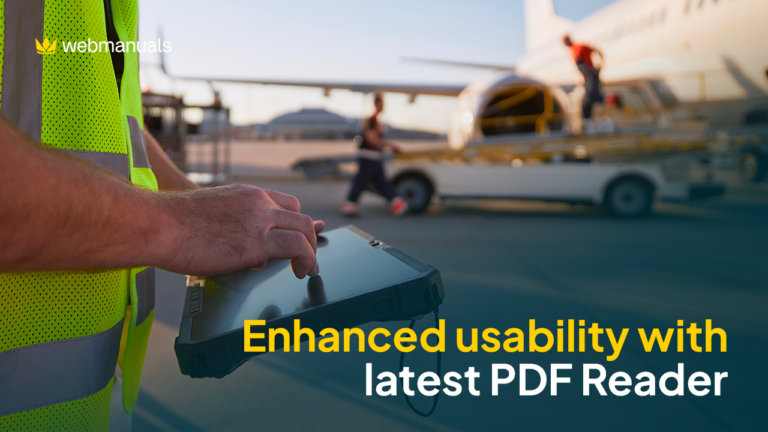Compliance can be a tedious and troublesome process at times. In this article, we are showing you some neat Web Manuals features that make staying compliant more comfortable and more time-efficient.
Handling aviation-related regulatory changes with Excel and PDF manuals
Have you ever been frustrated with keeping all excel spreadsheets that contain all your regulations and links to your 300-page manual fully up-to-date? You are not the only one. Countless problems come with working with the wrong tools.
For example, not everyone having the latest revision available is a big problem. In larger organizations, this leads to editors working on different versions of the same manual. Sending files back and forth between several people often resulted in some working on older revisions than others. We have heard of countless instances where this even resulted in the wrong version being distributed to the end-users. Accidentally deleting the latest version of the revision is also a result of the confusion that can arise when several versions of the same manual go around in the organization.
Why are Excel and Word not suited for writing and maintaining aviation manuals?
Using Excel for compliance and sending Word or PDF files back and forth can be very time-consuming. You spend much time on formatting manuals, especially in Word. For example, updating the List of Effective Pages, as well as content jumps between pages when you try to fix the revision bars. Those and many other similar details surrounding the actual content you are writing can be very frustrating. After all, you are working with large and complex aviation-specific documents in a software that is supposed to handle 40-50 simple pages. With Excel and Word, you don’t have another choice than to fix everything manually. How many hours do you usually spend on details that surround what you are supposed to do?
Staying compliant with aviation regulations process using Excel spreadsheets, Word and PDF
Our customers have many editorial horror-stories that surround aviation compliance and complex aviation documents. We have visualized the old fashioned way of staying compliant. The workflow below illustrates where you lose most of your time working this way. Your organization’s workflow might look something like this:
- Stay up to date with the latest FAA, EASA, IS-BAH, ICAO, IS-BAO or other regulations.
- Find out what’s new in the newest revision.
- Try to understand regulatory changes and identify which of your manuals are affected.
- Update the references in Excel and make sure they are connected to the correct places in your manuals.
- Edit all the Word files.
- Add, update, and remove revision bars.
- Update all page numbers.
- Update revision bars and dates once again – this step is being repeated throughout your revision until it’s finally published.
- Find and update all cross-references – not just in the current manual – but other manuals as well. Make sure there are no changes in the manuals that are being referred to.
- Edit LEP & Change Log for every change.
- Update crossrefs in Excel again.
- Publish docs to PDFs and compile them to one PDF.
- E-mail for review.
- Request feedback – Some pages are maybe not approved, so you go back to step #4 and start again from there.
- Upload and replace old PDF to make sure that only one revision is available.
- Notify all recipients per E-mail
Over a longer time period, this way of working puts a toll on your processes that keep you compliant. In the grimmest scenario, having the wrong revision distributed without anybody noticing might lead to a problematic audit, or the nightmare: you risk being non-compliant. Worst case, the aviation authorities could ground all your planes and operations until you handled the mistake.
The scenario above might all sound like a process issue in the organization. However, to put it simply, there are just better tools you can use to stay compliant. No process will ever be efficient if you are using the wrong tools. So what does the right tool do?
What do you need to stay compliant with changes to regulations?
To get a greater understanding of what you need, we suggest you watch the webinar from our colleague Tobias Nilsson. In this Webinar, Tobias will go through this topic in greater detail. He also shows you how it all works step-by-step in Web Manuals.
Watch it On-Demand here:
The Challenge of Staying Compliant
The challenge of staying compliant with regulatory changes in aviation summary:
To summarize the main points of this webinar, you need compliance and traceability towards aviation-specific regulations and standards. Doing this manually takes hours – you have to browse websites to find and understand updates to rules and regulations. You don’t get notifications about when there are updates to, for example, EASA or FAA regulations that affect your manuals. You might risk missing crucial information. This makes staying compliant a constant challenge.
You also need a streamlined process for editing and reviewing. Each of the different manuals has different steps that they have to go through. You need to be able to customize this process for each of your manuals. Of course, this is necessary when you have an audit when you need to make sure that all your processes are aligned with the updated regulations and show where the changes have been made.
You need control and overview to make sure that all the new changes are reaching everyone affected in your organization. You also need to make sure that everyone has read and understands the differences. Also, you need to prove that the changes have been successfully communicated to the organization. The only way to do this in a timely manner is through digital distribution.
How to save time on handling your aviation compliance with Web Manuals
So what can Web Manuals do for you? To put it simply, we automate all the details that otherwise would take all of your time while minimizing the risks of not meeting the regulatory requirements. Our customer Eliance Helicopter Global Services said it the best:
“Qualified people should not spend time on editing details that don’t matter. They should spend time on the actual content related to their expertise. Web Manuals helps us accomplish this.”
If you would like to know more about how we do this, please visit www.webmanuals.aero/compliance or watch The Challenge of Staying Compliant webinar. Here is a little preview of how Web Manuals works:
Stay compliant with a system that takes care of everything.
With Web Manuals, there simply are fewer steps when compared to the traditional way of working – this saves time and minimizes risks.
- Link regulations and requirements to your manuals (you only have to do this once)
- The system takes care of the rest – it will alert you when there are regulatory changes that affect you and your manuals.
- Edit your manuals with our fantastic Editing tool. Revision bars are automated, List of Effective Pages updates by itself, page and revision numbers are always up-to-date, the features go on and on.
- Easily Review your manuals and get instant feedback. With our customizable workflows, everyone always has access to the latest version of the current revision or draft.
- Distribute your manuals to everyone with one click.
- BONUS: Check who has read and who has not read the latest revision.
Doing compliance and traceability manually by hand takes too much time. You need a system to keep track and that informs you of new regulations, new regulatory changes, and changes to requirements. With the Web Manuals customizable workflow, you can make sure that you follow all the important steps in updating your processes and documents.
Check out Compliance Libraries to find out more.
Another feature related to staying compliant: Web Manuals checklist makes your audits more pleasant
Using the checklist in Web Manuals helps you during an audit. Instead of spending time searching for information that the auditor wants to see – you can easily navigate to the correct places in the correct manuals that the auditor wants to see.
How the system alerts you when there are regulatory updates or changes
After you have connected your compliance regulations to your documents, Web Manuals alerts you in case something is wrong. For example, you get an alert if a connected chapter has been edited, a heading is missing, your manual is archived, or if the regulation has changed. Find out more.
Main takeaways from this article
The main takeaway you should get from reading this article is that using the wrong tools to do a task takes a lot of time. Web Manuals is specifically designed to create aviation manuals and to keep you compliant with aviation regulations. Systems like Word or Excel do not offer much support for regulated and specific standards such as manuals for aircraft, OMAs, or similar. The aviation industry is highly regulated, and a lot of standards are required to remain airworthiness. The aviation industry simply requires more innovative tools and systems to handle effectively.
Thank you for reading! If you have any questions, do not hesitate to contact us or book a demo.




